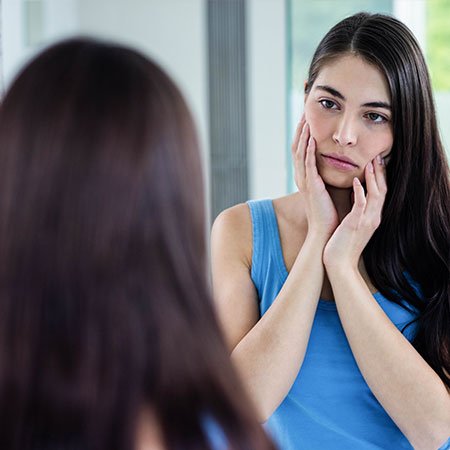Some quick facts related to Body Dysmorphic Disorder
- Body Dysmorphic Disorder is among the serious psychiatric disorders which are connected with obsessive-compulsive disorder. It affects men and women widely around the age of puberty.
- The individuals suffering from BDD or Body Dysmorphic Disorder are quite focused on their physical appearance, which others might not observe like nose, skin, hair, etc.
- The sufferers of BDD remained focused on repetitive behavior regarding the real or imagined physical appearance like cheek biting, skin picking, checking out mirror, hair pulling, etc.
- The people suffering from BDD are self-obsessed, and hence, they either love or feel ashamed of their appearance.
- Many individuals suffering from BDD are found to be shamed regarding their body or particular body parts, both internally and externally. They fear the denunciation or social evaluation.
- BDD is a mental issue that requires proper attention to getting control. The health issue can also disrupt the life, concerns and thoughts of the sufferer.
- BDD brings along too much of stress as the people have trouble concentrating even on minor things. This can have a negative impact on their academic performance.
- The treatment for BDD involves medications provided for cognitive behavioral therapy which helps in reducing the BDD symptoms to a great extent.
Body Dysmorphic Disorder or BDD – An Overview
Does any of your body part pinch you for spoiling your appearance? Do you dislike your appearance due to any curve, crocked teeth or even any birthmark? This happens to nearly everyone at the age of puberty. However, it is normal to some extent, but if anyone is too much obsessed with it, it is surely fishy. People in serious conditions might even be fanatical with any flaws, which may or may not even exist. And when such obsession takes hold over the mind, it is termed as Body Dysmorphic Disorder, which is surely dangerous.
Body Dysmorphic Disorder, shortly termed as BDD is a mental illness in which the individual suffers through too much stress and pessimism regarding their looks or appearance. The people diagnosed with BDD remain too much concerned about their flaws or keep finding them on their bodies that already exist or are imaginative. No matter how much other people or family members assure them that they are fine, they still disagree with the statement and continue with their mania related to the flaws which turn out to be troublesome as time passes.
The people having BDD are unable to control the negative thoughts and avoid the statement from others who keep on reassuring them about their appearance to be fine. Such thoughts can lead to unembellished emotional distress which interferes with their day-to-day functions. Due to this, they might avoid going to school, work, social gatherings, etc. and get isolated even from friends and family members, as they fear about others noticing the flaws.
Want to learn more about Body Dysmorphic Disorder? Keep reading further for getting complete details regarding the mental health issue.
What are the common features people having BDD concentrate on?
For the people suffering from BDD, looking for flaws on the body or face is quite common. But there are particular things the people having BDD concentrate on. Here is the list.
- Some facial features like the nose, lip size or shape, etc.
- Acne, scars, freckles, moles, etc. on the skin
- Tone and size of the muscle
- Shape and size of particular genitals like breasts
- The hair on the body or face
When this is observed, the individual widely thinks of either plastic surgery or getting a magic wand that fixes anything. But most importantly, such people need to look for the right technique that helps them in stepping out of their imaginative world and get a new opinion regarding their appearance which is additionally positive and holistic.
What are the symptoms and signs of having Body dysmorphic disorder?
The people having BDD are found suffering from obsessions regarding their outlook which can last up to hours or even days. Such obsessions are hard to control or manage due to which they lack the required concentration on anything other than their imperfections.
Here are some of the common signs and symptoms of having BDD:
- Remaining too much inattentive regarding the perceived flaws that can be minorly visible or totally invisible to others
- Having a strong belief of any minor to a major defect in the appearance which makes you look deformed or ugly
- Believing that others are taking special note about the appearance in a mock or negative way
- Getting engaged in behaviors that are meant for hiding or fixing the flaws which are totally difficult to control or manage, like grooming, looking at the mirror frequently, skin picking, etc.
- Trying hard to hide professed flaws with makeup, clothes, or other styling tips
- Constantly comparing your appearance with other family members, friends, or even surrounding people
- Often asking other people about your appearance and reassuring the same
- Developing the tendency of a perfectionist regarding every aspect
- Looking for different cosmetic procedures or surgeries for obtaining even a little satisfaction regarding the flaws
- Avoid going to social gatherings or social situations
- Suffering from emotional issues like feeling disgusted, depression, reduced self-esteem, anxiety, etc.
When the patients of BDD are preoccupied with their appearance, repetitive behaviors, and excessive thoughts it becomes difficult to control the situation leading to additional problems and stress in life like work, school life, social life, social gatherings, functions, etc.
What are the causes of BDD?
This might be surprising, but there are no particular causes that lead to BDD. Similar to other mental health issues, there are various factors that lead to BDD. The list includes anomalies in the structure of the brain, bad life experiences, and genetics. The past traumatic experiences of life, particularly the ones in childhood, criticism, and exploitation also are some essential facts that lead to BDD. The risk of having BDD also increases when an individual suffers from personal traits like perfectionism or anxiety.
Let’s check on the causes that lead to BDD.
1. Genetic factors
Yes, having a family member suffering from BDD can increase the chances of facing similar conditions as the inherited condition is among the reasons leading to BDD. Genetic factors play a vital role in BDD.
2. Obsessive-compulsive disorder
The people having OCD or obsessive-compulsive disorder are at high risk of suffering from BDD. Both OCD and BDD have similar genetic factors, as well as, the treatment for OCD is also found responding to BDD.
3. Visual Processing
The people suffering from BDD are more likely to overfocus on certain activities in detail like drawing various figures, checking out on images, etc. No doubt, there are no studies that relate such activities with BDD, some scientists still agree that such factors lead to BDD in some cases.
4. Neurotransmitter Serotonin
As per the scientists, some patients suffering from BDD are found to have low levels of the neurotransmitter serotonin in their body, however, it is not completely clear. Considering the treatment of BDD, serotonin is found to be effective in reducing particular complex symptoms.
Apart from all these, having constant thoughts in mind regarding the beauty of particular places can also lead to BDD to some extent. BDD comes with a severe impact on the life of the individual. When BDD combines with depression and anxiety, some people can also go for suicidal attempts which is surely a perilous situation.
Who is likely to suffer from BDD?
The people who are suffering from BDD don’t generally speak about it in public. They hide their anxiety from the society, and even the family members which make it difficult to track the health issue. The people who are likely to suffer from BDD include teenagers, pregnant women, and lastly women post-menopause.
In teenagers, children go through various changes in their body and accepting every change is difficult for some. Such transformations lead to body dysmorphic disorder. Again, during pregnancy and after pregnancy, the body goes through a lot of changes. After pregnancy, women highly expect getting back into that slim look, which is not possible for every woman. And this affects the lifestyle too, resulting in BDD.
Similarly, post-menopause, many hormonal changes are observed in women which results in changes in the figure and appearance. And those who fail to adopt such changes, are sure to overlook their appearance and suffer from BDD.
When should you seek some professional help?
BDD or body dysmorphic disorder is a mental condition that can be quite tricky to recognize. BDD needs some accurate and clear diagnosing to recognize the stage and plan the treatment accordingly. Again, the chances of the condition getting misdiagnosed are quite obvious because most of the people suffering from BDD hide their coercions and manias. This makes it essential for the people to be honest and open with the caregivers regarding their behaviors, feelings and thoughts they have for their body, and the issues related to it. If you are still not in touch with any mental health care professional, it becomes essential to talk with any physician for the initial medical evaluation and get the reference to any specialist for the issue.
Talking about the treatment for body dysmorphic disorder, it is basically a combination of medication and psychotherapy. Again, CBT or say Cognitive Behavioral Therapy is also found effective for the patients having BDD with particular antidepressant medications.
Cognitive-behavioral therapy helps in dealing with the tools and techniques that help in managing the patterns of negative thinking and irrational thoughts. For treating the people having BDD, a particular part of CBT is practiced known as Exposure and Response Prevention. This involves looking forward to opposing different situations which lead to irritations in public.
Antidepressants on the other hand contains serotonin which is helpful in reducing the symptoms leading to compulsive behaviors and obsessive thoughts. The antidepressants are quite effective as it reduces the effect of dysmorphia from the brain termed as serotonin. The doctors might keep on changing the dosage of antidepressants on observing how the body reacts to the medications and its possible side effects. When the symptoms become unmanageable or interfere with your routine, the patient might also be admitted to the hospital for further treatment for specialized care.
For making the treatment effective quickly, here is what the patient or the family members of the patient can do:
- Avoid skipping the sessions of therapy, even if you are not in the mood of talking with the patients
- When taking medications prescribed by the doctors, don’t skip them or stop them suddenly before talking with the doctor. If this is done, the symptoms may reappear
- Read magazines, blogs, posts, etc. about BDD as much as possible to learn about it and check how it is affecting your body and mind as well as your family members
- Check out the warning signs, see what triggers you and your symptoms the most and discuss it with the physician or therapist
- Keep yourself active physically as this helps in elevating the mood naturally
- Say no to drugs and alcohol as they can intermingle with the medications and worsen the symptoms
Apart from all this, the patients also need to work on their negative thinking or predictions as this can degrade the current situation. For this, try to manage the thoughts and if required, look for some help from your friends or family members. When such thoughts start attacking, surround yourself with good thoughts, comic images or videos, etc. rather than sitting alone and feel stressed.
Some doctors also ask to maintain a diary regarding the fears felt when feeling anxious. This helps in the treatment to a great extent. Again, along with all these efforts, the support from family members is also quite helpful in dealing with BDD. The family members can effectively help in discussing your insights and situations with the therapists for getting the right treatment plan as it helps in recognizing the negative patterns and dismantle them.
Summary
Body dysmorphic disorder is something that troubles not only the adults but the children also. Hence, for dealing with the disorder, both antidepressants and counseling are helpful. For this, proper education regarding the body, flaws, and strengths should be provided from the parents as soon as such the minor symptoms are observed. Developing positive thoughts and atmosphere helps in recovering from BDD as it also boosts self-confidence.
Getting to the right expertise in the field would help in going to the roots of the issue and resolve them. No doubt, many doctors suggest particular surgeries or cosmetic surgeries, but it is highly advisable to avoid such things.


















